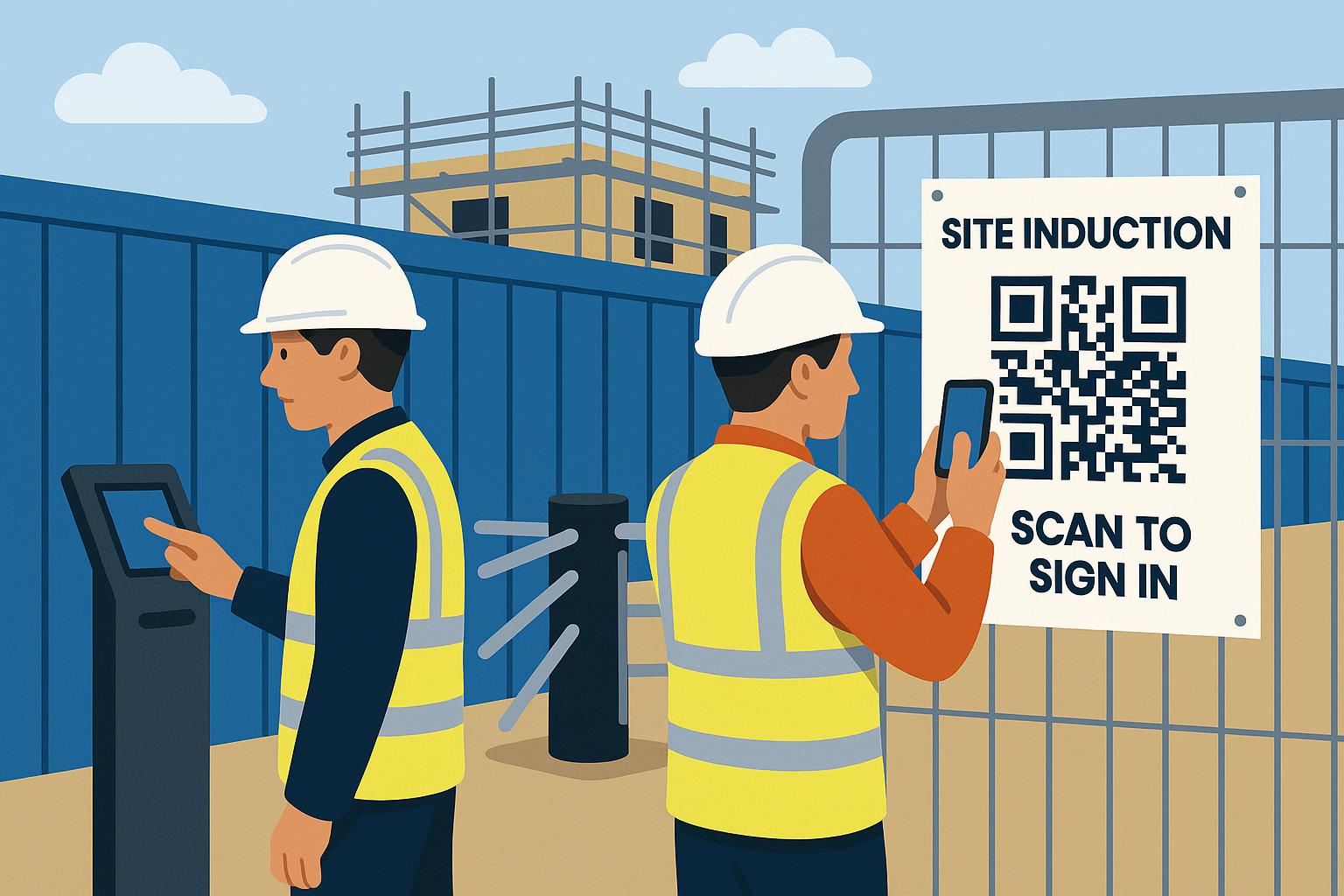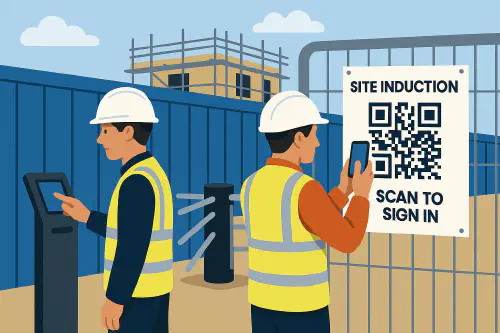
Site sign-in on construction jobs: QR code vs kiosk and how to set it up
Site sign-in on construction jobs: QR code vs kiosk and how to set it up
Category: Hiring, Training & HR Niche: site inductions, QR attendance, kiosks, emergency roll-call, GDPR

Site entrance with QR poster and touchscreen kiosk for sign-in
Contents
- Quick answer
- What HSE and CDM expect from inductions and sign-in
- QR vs kiosk: which is right for your site
- Step-by-step: set up QR sign-in with attendance logs
- Step-by-step: set up a low-cost induction kiosk
- Emergency roll-call: making headcounts reliable
- Costs, kit list and rollout plan
- FAQs
Quick answer
- If you need fast, low-cost sign-in on a small to mid-size job, use a fence poster with a QR code linked to a simple form. It works with any phone and lets you log attendance, trades, CSCS number and next of kin for emergencies. Pair it with your induction video and a short multiple-choice check.
- If you need controlled access, photo verification and no-phone workflows, use a tablet kiosk at the gate or a dedicated access system. More cost and setup, but better control and fewer missed sign-ins.
- Either way, make sure induction content, muster points and emergency routes are covered in the sign-in journey and in your Construction Phase Plan.
What HSE and CDM expect from inductions and sign-in
- Principal contractors must ensure a suitable site induction for every worker, and contractors must ensure their people are inducted. That sits under CDM 2015 reg. 13 duties on information and training. See HSE guidance on site rules and induction and the principal contractor role.
- Emergency arrangements must be in place and communicated, including evacuation, routes and assembly points, per CDM regs 30, 31 and 32. HSE’s HSG168 on fire safety reinforces the need for clear alarm, roll-call and accounting procedures.
- Keep your induction proportionate but site-specific. Visitors may get a shorter version if escorted, but still cover muster points and what to do on alarm.
QR vs kiosk: which is right for your site
QR sign-in
- Best for: fast mobilisation, small to medium sites, multiple dispersed access points, subcontractor-heavy jobs.
- Pros: very low cost, no hardware lock-in, works offline with some apps, easy to push updates.
- Cons: relies on workers’ phones, variable completion quality, harder to enforce one-person one-entry without checks.
Tablet kiosk (or access control)
- Best for: higher-risk or larger sites, where you need photo verification, preventing tailgating, or linking to turnstiles.
- Pros: stronger compliance, can force video viewing and quiz, optional photo capture and badge printing, more reliable headcounts.
- Cons: up-front hardware cost, power/enclosure needed, one point of failure if the tablet goes down.
Tip: Many firms run both. QR on perimeter gates and a kiosk at the main entrance for those without smartphones or to handle inductions that need verification.
Step-by-step: set up QR sign-in with attendance logs
Goal: a poster on the hoarding that sends workers to your induction form, logs attendance, and emails a day pass.
- Create your induction form
- Use Google Forms or Microsoft Forms. Collect: name, company, mobile, trade, supervisor, CSCS card number, emergency contact, declaration to follow site rules, and a short quiz on your induction video.
- Add conditional questions for visitors vs operatives.
- Link your induction video
- Host a private YouTube or OneDrive video. Keep it under 7 minutes. Cover who is in charge, PPE, site hazards, first aid, fire arrangements, nearest hospital, welfare, exclusion zones, hot works, traffic, and muster points.
- Generate the QR poster
- In Chrome, open the live form and choose Share, Create QR code, then download the PNG. Add your logo, Site induction Scan to sign in, and the site name. Print A3 on weatherproof stock and laminate.
- Attendance sheet and day pass
- Responses auto-fill a Google Sheet. Add columns for Inducted yes, Quiz score, and CSCS check done. Use a simple mail merge add-on to send a Day pass email with the person’s name, date and site rules.
- CSCS Smart Check (optional but recommended)
- Use the official CSCS Smart Check app to verify cards at sign-in. Record Checked in your sheet with checker’s initials.
- Data protection
- Put a short privacy notice on the poster with a link to your policy. Keep induction records only as long as needed for safety and compliance. Limit sheet access to managers.
- Test it
- Do a dry run with three subcontractors. Time the process, fix any slow steps, and update the poster if needed.
Step-by-step: set up a low-cost induction kiosk
Goal: a weather-sheltered tablet at the gate that walks people through sign-in and the induction.
- Hardware
- 10 inch tablet, anti-tamper enclosure, mains power or power bank rotation, 4G router as backup. Mount at 1.2 m height, weather hood if outdoors.
- Kiosk app
- Use a kiosk browser mode to lock the tablet to your induction form and video. Set the homepage to your form and disable navigation.
- Verification
- Add a compulsory photo capture field and signature. If you print badges, use a cheap label printer in the site office.
- Accessibility
- Include a language selector and headphones for audio. Offer a QR alternative beside the kiosk to avoid queues.
- Records
- Same Google Sheet workflow as above so your headcount is in one place. Back up weekly.
Emergency roll-call: making headcounts reliable
- Induction must state the alarm tone, exit routes and assembly points. Appoint wardens per zone and practice monthly drills.
- For roll-call, use the live sheet on a phone at the muster point. Assign one warden per contractor to tick off their people and report to the incident controller.
- Investigate any headcount gaps and update the plan after drills. HSE’s HSG168 covers evacuation and accounting for people on complex sites.
Costs, kit list and rollout plan
- QR poster setup: near-free using existing tools. Printing and laminating A3 posters costs a few pounds. Optional: short URL and NFC tag on the poster.
- Kiosk setup: tablet 100 to 200, enclosure 60 to 150, label printer 70 to 120, weather hood 40. Data SIM 5 to 10 per month.
- Rollout: pilot on one gate for a week. Brief supervisors. Add the sign-in method and muster point map to your CPP, RAMS and toolbox talks. Put a spare laminated poster in the site office.
FAQs
Q: Are QR inductions acceptable to HSE? A: Yes, if the induction is site-specific, understood, and records are kept. Format is up to you. Focus on content quality and proof of understanding. See HSE on site rules and induction.
Q: How do we handle people without smartphones? A: Provide a kiosk at the gate or a paper fallback. Keep at least one alternative sign-in route.
Q: What about emergency roll-call? A: Make sure your system gives a current headcount and that wardens know how to take attendance at the muster point. Drill monthly. See CDM regs 30 and 31.
Q: Do we need consent for collecting CSCS numbers? A: You need a lawful basis under UK GDPR, usually legitimate interests for safety and competence checks. Keep the data secure and for no longer than necessary.
Q: Can we add languages? A: Yes. Offer a language selector and link to translated inductions. See our guide on How to translate RAMS and site inductions safely with AI.
Q: Any YouTube guides worth watching? A: Calm Inductions and similar providers have demos of QR sign-in workflows. For CSCS verification, use the official CSCS Smart Check.
Want to slash training times and increase revenue per Engineer? Join our Waitlist: https://trainar.ai/waitlist